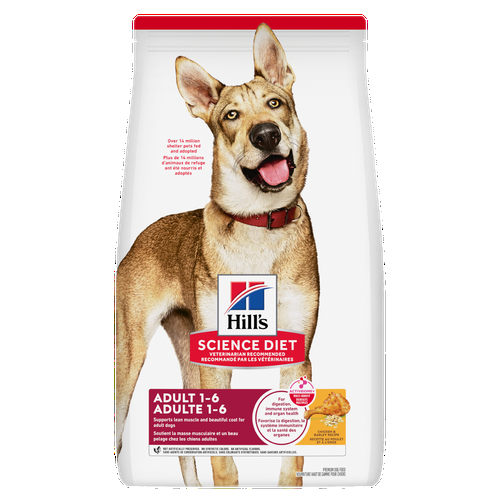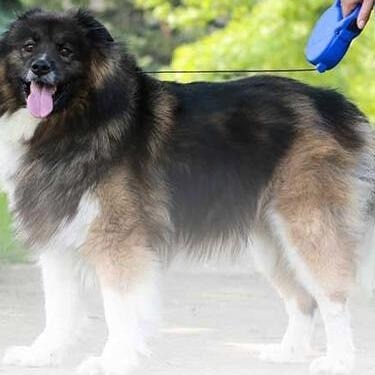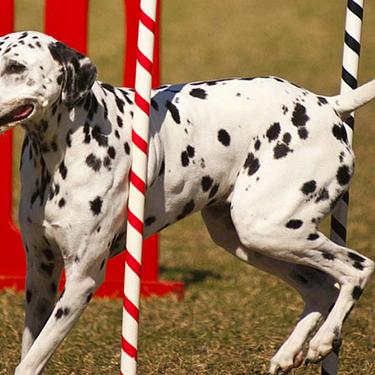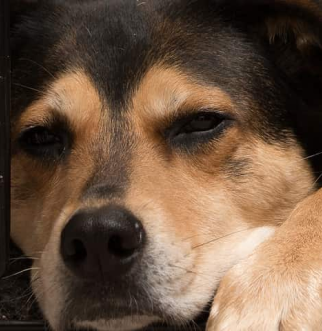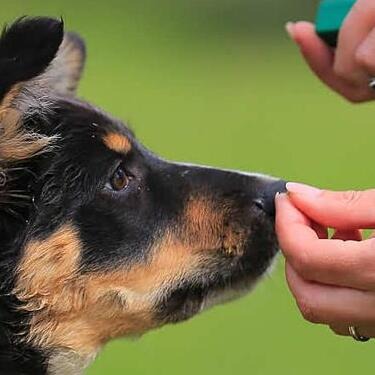Medium and compact, shar-peis are distinctive-looking members of the non-sporting group. Identifiable primarily by the loose, wrinkled skin covering their head, neck and shoulders, shar-peis are also recognizable by their broad muzzle and small triangular ears. They tend to have a scowling expression due to the loose folds of skin that hang over their brow. The shar-pei is also unique for its blue-black tongue, a trait shared with only one other breed — the chow chow.
Standing about a foot and a half from the neck and shoulders down, shar-peis grow into the heavy folds of skin that cover them as puppies. Their thick neck and broad chest give them a sturdy look without making them overly stout. Their long, thick and tapered tail is set high and tends to curve over one side of the back haunch.
Shar-peis are also distinguished by their rough, sandpaper-like coats that can be any solid color or sable mix. Shar-pei literally means "sand skin" in Mandarin. The American Kennel Club (AKC) identifies two acceptable coat lengths: the extremely short "horse coat" and the slightly longer "brush coat," which is no longer than an inch at the withers. The shar-pei's hair tends to stand up straight along the main trunk but lies flatter along the limbs and tail.
Originally bred to guard livestock, shar-peis are alert, intelligent and protective dogs who make excellent guardians. They possess a calm and devoted nature that makes them loving companions. They tend to be aloof with strangers, but are fiercely loyal and affectionate with their own people and love to spend time in the company of their families.
While shar-peis can be aggressive toward other dogs, says Dogtime, early socialization can help them learn to get along with other pets. Providing them with socialization and obedience training as puppies can also make them easier to handle as adults, as shar-peis are strong-willed dogs whose personalities may overwhelm an unprepared pet parent. These dogs do best with confident, assertive leadership to help them know how to properly behave.
Shar-peis are laid-back, low-energy dogs. Because they don't require much exercise, they can make good apartment dogs. Just keep in mind that they need short walks to stretch their legs if a backyard isn't available.
Due to their stubborn streak, shar-peis need lifelong reinforcement of training and socialization. Their propensity for aggressiveness toward other dogs means they should always be kept on leash and allowed near strange dogs only under strict supervision. The good news is that the shar-pei dog breed is intelligent and eager to please their pet parents, which makes them fairly easy to train. Consistency is key to successfully training shar-peis and preventing them from unlearning their training.
Although shar-peis are not flat-faced like bulldogs or pugs, they do have shorter-than-normal noses and are considered brachycephalic. Because of this, shar-peis don't do well with vigorous exercise like running or jogging. Stay extra vigilant to ensure they don't overheat in warm weather, especially in high humidity.
The coat of the shar-pei is extremely easy to groom. They only require brushing once a week to remove shedding hair, dirt and excess dander, and only need bathing once every few months — unless they get excessively dirty. After bathing, take the time to thoroughly dry between their folds and wrinkles to prevent a fungal infection. Gently wipe their ears on a weekly basis and check them for signs of infection, such as odor or redness.
The shar-pei is an ancient breed, dating back more than 2,000 years to China's Han Dynasty. It's thought to have been bred by peasants to perform tasks including hunting, herding and guarding livestock from predators and thieves. Unfortunately, shar-peis were also frequently used as fighting dogs, which accounts for their aggression toward other dogs.
Matgo Law, a breeder from Hong Kong who was passionate about the shar-pei breed, introduced them to American breeders in the early 1970s. This resulted in shar-peis becoming extremely popular in the U.S., especially in the 1980s. The AKC recognized it as an official breed in 1992. Since then, the shar-pei has declined in popularity but still enjoys a broad base of fanciers. Today there are over 70,000 shar-peis registered with the AKC in the U.S.
Adopt a pet. Change a life.
Are you prepared to adopt a pet? Use these tools to make sure you are ready for the commitment.
Adopt a pet. Change a life.
Are you prepared to adopt a pet? Use these tools to make sure you are ready for the commitment.


